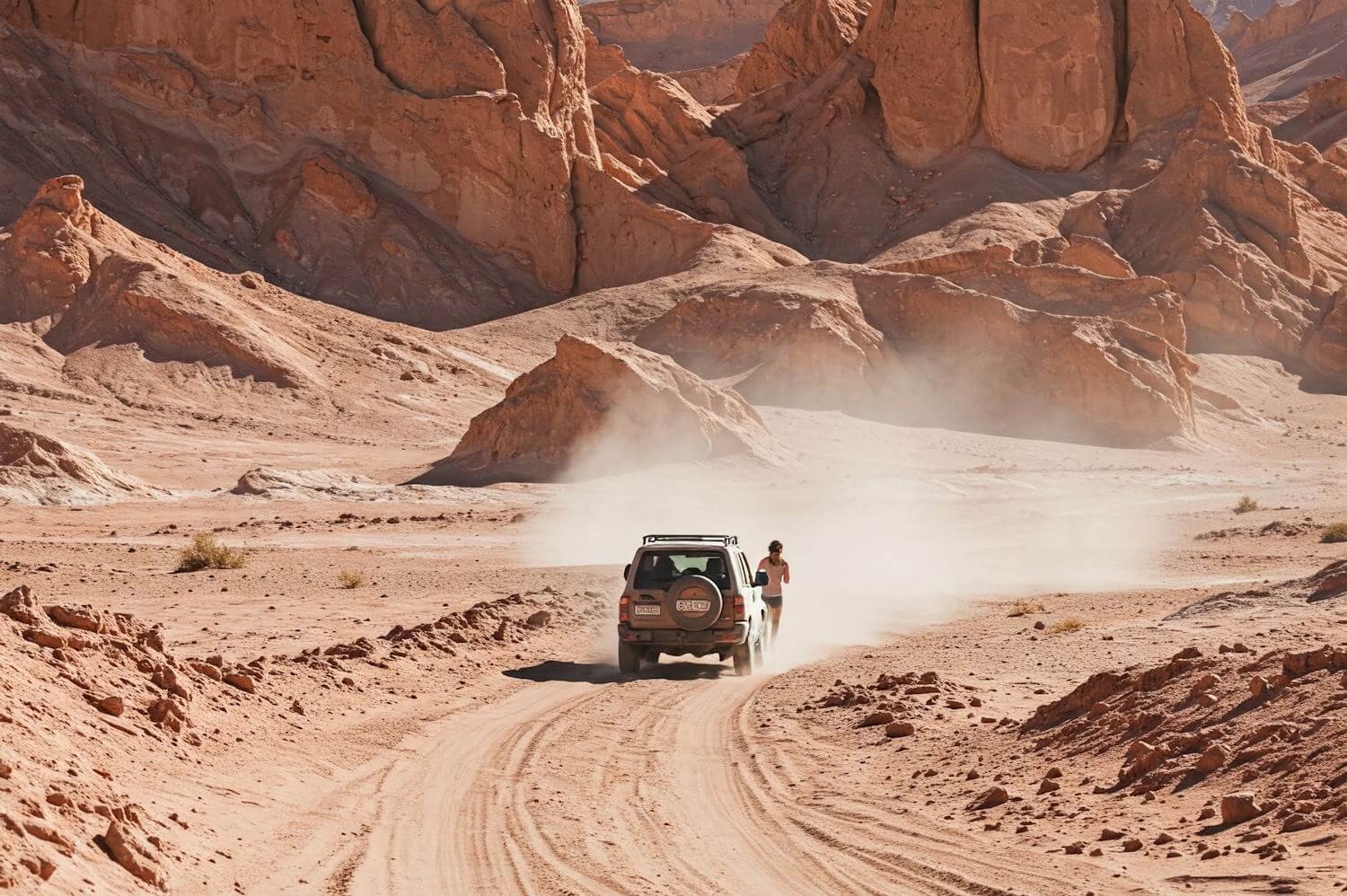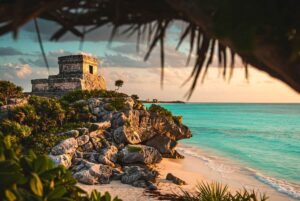Introduction to the Atacama Desert
The Atacama Desert, located in northern Chile, is renowned as one of the driest places on Earth. Spanning approximately 1,000 kilometers along the Pacific coast, this unique geographical region showcases an array of striking landscapes that range from salt flats and volcanic formations to wind-sculpted rocks and vast dunes. The inhospitable climate is characterized by extremely low rainfall, with some areas receiving less than 1 millimeter of precipitation annually. This contributes to the otherworldly appearance of the desert, where both flora and fauna have adapted to survive in such arid conditions.
The desert’s remarkable geological features include the Altiplano plateau, the Andes mountains, and numerous salt flats, which collectively create a visually stunning tableau. The terrain has been shaped over millions of years by tectonic activity, extreme temperatures, and wind erosion, leading to an abundance of unique rock formations and geological phenomena. These characteristics make the Atacama Desert an intriguing site for both geologists and travelers alike.
In terms of biodiversity, the Atacama Desert is surprisingly rich. Although the harsh conditions seem unwelcoming, many resilient species of plants, such as the iconic llareta and the vibrant yellow flowers of the Atacama flora, manage to bloom during rare rainfall events, creating an ephemeral but breathtaking display. Wildlife, including the adorable vicuñas and various bird species, can also be observed in specific areas where water sources are present, offering glimpses of life in this extreme landscape.
Travelers embarking on a drive through the Atacama Desert can expect an unforgettable experience, characterized by stunning vistas, unique geological formations, and a chance to witness the remarkable adaptability of life in one of the most extreme climates on the planet. Whether one is seeking adventure, scientific discovery, or simply appreciation of natural beauty, the Atacama Desert promises an encounter with a truly surreal environment.
Planning Your Drive: Essential Tips
Embarking on a road trip through the Atacama Desert requires thorough planning to ensure a safe and enjoyable experience. The best time to visit is typically between March and May or from September to November, as temperatures are more moderate and precipitation is minimal during these months. Travelers should be aware that the desert can experience extreme temperature fluctuations, so packing layers is advisable.
When considering a vehicle for your Atacama adventure, a high-clearance 4×4 is highly recommended. Many of the routes can be challenging with loose sand and rocky terrain; thus, a suitable vehicle will help navigate these conditions more effectively. Additionally, ensure that your vehicle is well-maintained and equipped with spare tires, tools, and extra fuel—fuel stations are few and far between in this remote region.
Essential supplies for your journey include ample water, food, sunscreen, hats, and first aid kits. It is also advisable to carry extra fuel and an emergency blanket as temperatures can drop significantly at night. As you travel through the desert, keep in mind that distances between key points can be vast. For example, the distance from San Pedro de Atacama to the Tatio Geysers is approximately 90 kilometers, which can take around two hours of driving. Therefore, it is wise to plan your itinerary carefully, allowing adequate time to explore each site without feeling rushed.
Having a reliable map or GPS is crucial as cell service can be unreliable in remote areas. Opt for a printed map in addition to GPS navigation to avoid getting lost. While the roads may be marked, features such as changing weather conditions may obscure visibility. Adequate preparation ensures travelers can enjoy the breathtaking landscapes and unique geological formations that the Atacama Desert has to offer.
Key Stops Along the Route
The Atacama Desert offers a plethora of stunning locations that are ideal for exploration during a drive through this otherworldly landscape. One of the must-visit locations is the captivating Valle de la Luna, or Valley of the Moon. This unique area resembles the lunar surface due to its surreal rock formations and vast salt flats. Visitors are often drawn to the breathtaking sunsets that paint the sky in vibrant hues, creating a mesmerizing backdrop against the stark landscape. Hiking trails wind through the valley, providing an opportunity to experience its geological wonders up close.
Another significant stop along the route is the expansive Salar de Atacama, which is the largest salt flat in Chile. The salt flats are an exceptional sight, characterized by their shimmering white crusts set against the backdrop of majestic mountains. One prominent feature of the Salar is the vast lagoons that surface during the rainy season, attracting various wildlife, including flamingos. Visitors can partake in guided tours to appreciate the unique ecosystem, particularly its diverse birdlife and distinctive geological features.
Additionally, the Altiplanic Lagoons, located at a high altitude in the Andes, present another remarkable sight that should not be missed. This collection of turquoise and emerald-colored lagoons, framed by dramatic mountains and sprawling landscapes, offers a tranquil experience. The lagoons are popular for photography enthusiasts and those seeking solitude amid nature. Trekking around the area allows visitors to immerse themselves in the untouched beauty of the region while spot various flora and fauna, including the vibrant vicuña. Each of these stops highlights the unique and striking characteristics of the Atacama Desert, inviting travelers to engage with its breathtaking natural environment.
Breathtaking Views: Landscape Features
The Atacama Desert, renowned for its otherworldly landscape, presents a plethora of stunning features that leave visitors in awe. Among these are the striking rock formations that dot the terrain. These formations, shaped by millions of years of erosion, showcase extraordinary shapes and hues, offering a visual feast for travelers and landscape photographers alike. The color palette of the rocks ranges from deep reds to vibrant yellows and soft browns, creating a captivating contrast against the often blazing blue skies.
Another prominent feature of the Atacama is the expansive salt flats, particularly the Salar de Atacama. This vast expanse of white salt creates an almost surreal landscape that can appear to stretch infinitely. The shimmering surface, particularly during sunrise and sunset, can evoke a sense of calm and wonder. As the daylight transitions, the salt flats reflect a spectrum of colors, enhancing the desert’s magical ambiance and presenting unique photography opportunities for those who appreciate the interplay between light and landscape.
The flora of the Atacama also contributes to its breathtaking views. Though often perceived as a barren environment, certain regions host remarkable examples of resilience. Unusual plant life, such as the iconic Llareta and various cacti, thrives in specific microclimates. These plants often bloom briefly after rare rainfall, transforming the arid landscape into a vivid showcase of colors and textures. Capturing these moments can be particularly rewarding for nature photographers, as the delicate blooms create exquisite focal points against the stark background.
Finally, the sunsets in the Atacama Desert are nothing short of spectacular. As the sun dips below the horizon, the sky ignites in a symphony of colors, ranging from fiery oranges to deep purples. This breathtaking display enhances the already dramatic landscape and provides an unparalleled opportunity for capturing stunning photographs that reflect the desert’s ephemeral beauty. Together, these landscape features weave an intricate tapestry that epitomizes the Atacama Desert’s allure.
Flora and Fauna: Life in the Desert
The Atacama Desert, often regarded as one of the driest places on Earth, fosters a surprising wealth of biodiversity, showcasing remarkable adaptations in both flora and fauna. The plants and animals inhabiting this unique environment have evolved distinct strategies to survive the intense heat, infrequent rainfall, and high salinity levels. Among the endemic plant species, the Atacama Desert rose stands out for its ability to thrive in arid conditions, exhibiting fleshy leaves that minimize water loss and vibrant blooms during rare moisture events.
Another crucial component of the desert’s flora is the extensive root systems of many plants, which seek out deep subterranean water sources. These adaptations allow species like the calafate bush and various cacti to endure the harshest conditions. In contrast, many of the desert’s fauna have also adapted remarkably to the extreme environment. For instance, guanacos, a type of wild camelid, possess physiological features that enable them to go long periods without water, drawing moisture from the plants they consume. Their desert survival skills are critical to maintaining the ecological balance within this challenging ecosystem.
The Avifauna of the Atacama is equally fascinating, as illustrated by the presence of flamingos, which are often seen in the region’s saline lagoons. These birds are well-adapted to the region’s high salinity, filtering the water for their primary food source of brine flies and algae. The Atacama Desert serves as an essential habitat for migratory bird species that rely on its unique ecosystems during seasonal changes.
Conservation efforts are increasingly vital to preserving the Atacama’s distinct biodiversity. Initiatives aim to protect these endemic species from threats such as climate change, habitat degradation, and human encroachment. By focusing on sustainable tourism and habitat restoration, there is hope for the ongoing survival of the unique plants and animals that call the Atacama Desert home. Through these efforts, future generations may continue to appreciate the enchanting life that thrives in this extraordinary landscape.
Cultural Insights: Indigenous Communities
The Atacama Desert, often regarded as one of the most arid places on Earth, is not just notable for its rugged beauty and unique landscapes; it also serves as the home to rich indigenous cultures, particularly the Atacameños. This community has inhabited the region for thousands of years, developing a profound connection with the harsh environment and adapting their traditions and lifestyles to the desert’s unique challenges.
The Atacameños, also known as the Likan Antai, have traditionally relied on agriculture, mining, and livestock herding for their sustenance. They ingeniously cultivated crops such as quinoa, potatoes, and various native plants, using ancient techniques that emphasize respect for the fragile ecosystem. Their ability to thrive in such an inhospitable climate showcases not only resilience but also a deep understanding of their surroundings, underscoring how intimate knowledge of the land can inform sustainable practices.
Cultural expressions among the Atacameños include vibrant textiles, intricate pottery, and ceremonial practices rooted in their history and environment. Traditional festivals, often celebrated with music and dance, reflect their connection to the earth and the cosmos. Visitors to the Atacama region have the unique opportunity to engage with these cultures through local tours and experiences. Guided tours led by indigenous community members can provide insights into their daily lives, allowing travelers to witness craftsmanship and partake in ceremonial rituals, offering a deeper understanding of Atacameño heritage.
Moreover, various cultural centers and museums in the area display artifacts and offer workshops on traditional crafts, further enriching the visitor experience. Engaging with the Atacameños not only promotes cultural appreciation but also supports the sustainability and preservation of their traditions, making each visit an exchange that honors the past while nurturing the future.
Stargazing in the Atacama: An Astronomical Experience
The Atacama Desert, often heralded as one of the driest places on Earth, offers a unique experience for stargazing enthusiasts. Renowned for its remarkably clear night skies, the region’s high altitude and minimal light pollution create an almost unparalleled environment to observe the cosmos. This extraordinary clarity allows even novice astronomers to spot myriad celestial phenomena, making the Atacama an ideal destination for both casual observers and seasoned astronomers.
Among the many features contributing to the Atacama’s stellar reputation are several world-class astronomical observatories, including the Atacama Large Millimeter Array (ALMA) and the Paranal Observatory, home to the Very Large Telescope (VLT). These facilities provide significant contributions to global astronomical research, allowing scientists to explore cosmic events such as supernovae, the formation of galaxies, and even the analysis of exoplanets. Visitors to these observatories may have the opportunity to participate in guided night sky tours, further enhancing their stargazing experience.
While driving through the desert, there are several tips to maximize your stargazing experience. First, it is essential to choose a dark location far removed from city lights; many scenic viewpoints and remote areas in the desert are perfect for this. Bringing along a star map or a stargazing app will assist in identifying various constellations and celestial bodies, enriching the experience even further. Additionally, consider using a telescope or binoculars for a closer view of planets and nebulae. However, the naked eye itself is also capable of revealing breathtaking sights such as the Milky Way stretching across the sky.
Preparing for cooler night temperatures by dressing appropriately can also significantly enhance comfort while stargazing. Taking the time to sit back and fully absorb the beauty of the universe can create unforgettable memories in one of the more extraordinary landscapes on our planet.
Challenges of Driving in the Atacama
Driving through the Atacama Desert presents a unique set of challenges that drivers should be prepared for. One of the foremost considerations is the extreme weather conditions. The Atacama Desert is one of the driest places on Earth, which might give the impression of a stable climate. However, temperatures can fluctuate dramatically between day and night, sometimes exceeding 30°C (86°F) during the daytime and plummeting below freezing at night. Therefore, it is important to dress in layers and ensure that your vehicle is equipped with adequate heating and cooling systems to handle these extremes.
In addition to unpredictable weather, navigating the rough terrains of the Atacama poses another challenge. The desert landscape consists of rocky paths, sand dunes, and various natural obstacles, which may not be suitable for standard vehicles. It is advisable to drive a high-clearance four-wheel-drive vehicle to navigate these difficult terrains safely. Familiarizing oneself with the terrain and having an updated map or GPS device can also greatly assist in navigation, as many areas will lack clear signage.
Another challenge associated with driving in this region is altitude sickness. The Atacama Desert sits at an average elevation of about 2,400 meters (about 7,874 feet) above sea level, and some areas climb even higher. Symptoms can vary from mild headaches to more severe effects that can impair driving ability. It is crucial to acclimatize properly by spending time at lower altitudes before embarking on your journey. Staying hydrated and taking breaks to rest can also reduce the risks associated with altitude sickness.
By preparing appropriately for climate variations, navigating rough terrains skillfully, and managing altitude sickness, drivers can successfully experience the captivating beauty of the Atacama Desert while ensuring their safety and enjoyment.
Conclusion: The Allure of the Atacama Desert
The Atacama Desert, often described as one of the driest places on Earth, presents a captivating landscape that draws adventurers and nature enthusiasts alike. This region of Chile, with its stunning vistas of salt flats, volcanoes, and unique rock formations, evokes a sense of wonder and intrigue. Exploring the Atacama is not merely a journey through a physical space, but an immersion into a realm that feels almost extraterrestrial. Each corner reveals a new spectacle, showcasing the raw beauty of our planet.
Visitors to this remarkable desert often find themselves enchanted by its stark contrasts and vibrant colors. The interplay of the golden sands with the brilliant blue skies creates an enchanting environment that is both serene and surreal. The vastness of the landscape engenders a sense of peace, as the quietude of the region encourages reflection and appreciation for nature’s artistry. Moreover, the desert’s diverse ecosystems offer an array of fauna and flora, revealing life in the most unexpected places. This resilience of life amidst harsh conditions is a powerful reminder of the adaptability of nature.
Moreover, the Atacama Desert provides myriad opportunities for adventure activities, from stargazing under its pristine night skies to hiking through its breathtaking terrains. The thrill of exploration, coupled with the ancient cultural heritage of the indigenous people, ensures that every visit leaves an indelible mark on the traveler’s memory. Embracing the allure of the Atacama Desert allows for unique experiences that resonate long after one has departed. If an adventure beckons, the Atacama stands as a testament to the extraordinary beauty and wonders that our world has to offer, inviting all to discover its magic.




